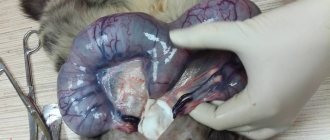When a cat climbs into the arms of its owner and curls up comfortably, purring loudly, it is impossible not to cuddle this miracle, stroke it and kiss it. But veterinarians advise against doing the latter. Not only is this unpleasant, first of all, for the cat itself, but it also threatens the owner with various diseases. Especially if your pet does not live at home all the time, but goes for walks outside.
Why can't you kiss cats?
Why you can't kiss cats and kittens
Among superstitious people who believe in mysticism, there is a widespread view that cats should not be kissed for the reason that this drains a person’s vital energy, which cannot always be fully replenished. However, the seriousness of the situation does not lie at all in some subtle matters. If something unwanted passes to the owner when it comes into contact with fur or saliva on the cat’s face, then these are cat microorganisms, not all of which are harmless. The point is not that not all cats are highly clean, unlike most representatives of their kind. Wool itself is an excellent “nursery” for various kinds of microorganisms, which means that when kissing, contact with them is inevitable.
Cat fur contains microorganisms, not all of which are harmless.
Signs that say you shouldn't kiss pets
According to signs, you should not kiss pets. Since ancient times, cats have been considered mystical animals. This fact has given rise to many superstitions about them.
One of the signs says that kissing a cat takes away vital energy from a person. No energy during the day, fatigue and apathy? Maybe you kiss your furry friend often?
They say that a person stops paying attention to other family members, finding himself at the complete mercy of the pet. Literally becomes his slave, fulfilling his every whim.
But how can one distinguish the effect of superstition from great love and care for a pet? The question is controversial.
And another sign says that a cat can easily lose its sense of smell after a kiss. Veterinarians deny this information, but signs are signs. Whether you believe in them or not is up to you to decide.
Is it possible to kiss domestic cats?
There is only one conclusion: kisses and close hugs are undesirable for either the pet or the cat’s owners.
Another source of concern is fleas, which can bite and even carry some diseases. Yes, if the cat is an indoor cat and does not go outside, then it most likely does not have insects (although the animal’s “homebody” does not give a 100% guarantee). But in addition to fleas, dust mites live in animal fur, invisible to the eye and causing severe allergies in many people. This is the very notorious “cat allergy”, which, according to the latest scientific research, does not exist. Or rather, it exists, but the cat has nothing to do with it, it’s not the animal at all, but the dust mites. Therefore, those prone to allergies should refrain not only from kissing, but even from bringing animal fur close to their face - this applies to those who like to tinker and sleep with cats as if they were soft toys.
Life cycle of a cat flea
Another source of trouble is cat saliva. Even with absolute confidence that the pet has been treated for parasites. The saliva of mammals contains a certain set of proteins characteristic of each species. When you kiss on the face, some amount of saliva necessarily enters the person’s oral cavity. And here questions may arise: where did the inflammatory processes come from, since the cat doesn’t go for walks, its owners regularly take it to the veterinarian to get rid of parasites? The fact is that the human immune system clearly perceives a foreign protein as hostile and immediately tries to neutralize it. As a result, immunity decreases for some time, but the risk of infection with all sorts of unpleasant ailments increases, the most harmless of which are gingivitis and stomatitis. This is why you can’t even kiss your pet pussies on the faces.
It is also better to simply stroke the sides and back, without kissing - the fur contains microorganisms that are “native” to the cat, but are completely alien to people and the immune system begins to reject them.
Video - Reasons why you shouldn't kiss cats
Something about cat hygiene
A cat, in general, is a very clean animal; it cannot be called dirty. She defecates in certain places, “cleans up” after herself, constantly licks herself, and loves to rest in clean places. But most cats have fur, and this is an excellent habitat for many parasites. If you kiss a pet, contact with microorganisms is inevitable.
Pets that live indoors and do not go outside are unlikely to become infected with fleas. But dust mites can accumulate in their fur, which are invisible to the human eye. Microscopic mites are a source of severe allergies. By and large, you can’t not only kiss a cat, you can’t even touch the animal’s fur with your face
A domestic cat trained to a litter box will always go to this place. But often she gets her paws dirty in feces, and then spreads her footprints around the apartment. They may also be invisible, but in such an environment much more microbes accumulate. Even the most hygienic owner does not attach much importance to this fact. However, when trying to kiss a cat, people notice a large number of microorganisms on the skin.
Among other things, the “mustachioed-striped” ones have a completely different immunity. They are more resistant to pathogenic microbes than humans. The cat may not get sick itself, but it will be a carrier of viruses, bacteria, and fungi that are dangerous to human health. They are transmitted by kissing an animal. Many infections cannot be noticed and do not cause symptoms in the carrier.
Based on this, we can draw an unambiguous conclusion: cat petting is not hygienic, even if the pet looks clean and well-groomed. Kissing a cat is dangerous.
What can you get infected by kissing cats?
So, it's clear that a kiss is not the best way to express your love for your furry pet. Among the “surprises” may await:
- Protozoa bacteria (they do not pose a danger to a person with a strong immune system).
- Staphylococcus (some types pose a threat to humans).
- Salmonella (very rarely cats act as carriers).
- Toxoplasmosis (the pathogen hides in the animal’s feces and, when released into the external environment, becomes passive and develops only under favorable conditions. The risk of getting sick is low if you wash your hands after cleaning trays, but it is better for pregnant women not to do this).
- Fungal infections, for example, ringworm (not dangerous to human life, but it will take a long and unpleasant time to fight).
- Helminths (tapeworms, nematodes, echinococci, roundworms).
The process of infecting a cat with worms
If a four-legged family member walks on the street, then this is even more dangerous - he catches birds and rodents, carriers of various kinds of viruses, including those dangerous to people.
Dangerous neighborhood
By receiving good nutrition and regular grooming, your pet can look completely healthy: well-fed sides, radiant eyes, shiny coat. However, it can be a carrier of pathogenic particles dangerous to humans, including viruses, bacteria, fungal microflora and parasites.
If a cat has access to the street and “walks on its own,” then the likelihood of bringing infection into the house on its paws and fur increases tenfold. Dirty travel through garbage cans and basements, eating garbage, contact with rats and unkempt stray creatures increases the risk of transmitting pathogens of dangerous diseases to owners:
- Rabies . The deadly virus usually enters the bloodstream through the bite of a sick animal. However, there have been cases of infection through saliva that gets onto the wound surface of the skin or mucous membrane. In the wild, the main source of the disease is foxes, and in the city - stray dogs and cats. The virus spreads along nerve fibers and affects the central nervous system, leading to aggressive behavior, paralysis and death. Veterinarians warn: you should never touch, much less pick up or press an unfamiliar cat to your face. The closer the site of initial penetration of the pathogen is to the head, the shorter the incubation period and the less time to take preventive measures and administer a life-saving vaccine.
- Toxoplasmosis . The causative agent of toxoplasmosis is the microscopic parasite Toxoplasma gondii, which enters the body through contact with infected animals, their blood, entrails and feces, as well as through eating poorly cooked or fried meat. If a pet is a carrier of toxoplasma, the owner can easily become infected by changing the litter in the cat's litter box and forgetting to wash their hands afterward. Some people have asymptomatic toxoplasmosis, while others experience a slight increase in temperature, conjunctivitis, lethargy, swollen lymph nodes, and dysfunction of the liver, heart, and nervous system. Toxoplasma poses a particular danger to pregnant women, causing intrauterine fetal death, serious developmental disorders and the birth of an oligophrenic child.
- Salmonellosis . This is a highly contagious infectious disease of animals caused by bacteria from the genus Salmonella and affecting mainly the digestive and respiratory systems. In young animals, the disease is severe, with general intoxication, fever, signs of acute gastroenteritis and bronchitis. A pet can become infected with salmonella through contact with sick pets, birds and harmful rodents. If sanitary standards are not observed at poultry farms, poultry carcasses and eggs become the source of the disease. A person runs the risk of getting salmonellosis by caring for a sick kitten or eating meat products that have not passed veterinary control.
- Chlamydia . In cats, the intracellular bacterium Chlamydophila felis most often affects the eyes, leading to chronic conjunctivitis. In babies from 1 to 3 months, severe inflammation of the mucous membrane of the eyes and profuse lacrimation are accompanied by decreased activity, runny nose, swelling of the throat and bronchitis. Mature cats become infected through sexual contact, newborn kittens - when passing through the female's birth canal. In humans, the course of feline chlamydial conjunctivitis has a lubricated form and proceeds easily. Infection is possible through contact with a carrier animal. For treatment, eye ointments containing antibiotics are used.
- Dermatomycoses . Fungal infections of the skin, known as ringworm, lead to redness, itching, dandruff, bald patches and brittle hair. The course of the disease is complicated by the addition of a pyogenic infection. Young children are most sensitive to dermatomycosis due to instability of the immune system and non-compliance with mandatory hygiene rules. If symptoms of the disease are detected in a cat, treatment should be started immediately, and all family members should undergo a preventive examination by a dermatologist.
- Helminths . Cats can be hosts to several types of parasitic worms (worms), which live primarily in the intestines, but cause intoxication of the entire body. Kittens are most often infected with roundworms (nematodes), the most common of which are roundworms. Their number can be so great that the intestinal wall ruptures and the baby dies from peritonitis. Adult animals are infested with tapeworms, the most dangerous of which is echinococcus. In the human body, the larva travels through the bloodstream into the liver and forms blisters there, in which it slowly develops and grows. Cats become infected with helminths from each other, or by eating raw meat, liver, or fish with microscopic larvae. Freshwater bodies of water are especially unfavorable, so it is recommended to thoroughly boil the catch from there. Worm eggs are released into the external environment with feces and often remain on the animal’s fur, so a person can become a carrier of helminths during daily interaction with a cat. As a preventative measure, you should regularly give your pet antihelminthic drugs and avoid feeding poor-quality food.
Do cats like to be kissed?
A logical question arises: how does the cat herself feel from hugs and kisses from her owner? Surprisingly, very few murks perceive this as affection and would like to receive it again and again. On the contrary, they see this as some kind of act of aggression and try in every possible way to avoid such a manifestation of feelings - they worry, hiss, and sometimes use their claws. It's simple - cats and people are not brothers and their ways of expressing emotions are completely different. If a cat responds to kisses with bites or scratches, this does not mean that it is aggressive or ill-mannered - it means that it has encountered an alien type of communication and does not understand how to behave. Or, on the contrary, she has already understood and clearly makes it clear to the person: “Stop it.”
Not every cat likes being kissed
At-risk groups
The categorical nature of doctors forces one to deny their point of view, but there is some rationality in the prohibitions. A cat can be a carrier of a variety of infections, and if its immune system keeps the disease in check, no symptoms will appear.
For example, small mites live on the skin of dogs, cats and people. Parasites are part of the skin ecosystem and behave very modestly while the immune system controls the body's condition. In case of immunodeficiency, these modest mites go on the attack and the animal/human develops demodicosis.
Close contact with cats whose health status has not been checked should be avoided by the following groups of people with reduced immunity:
- Newborns - parents should make sure that the cat communicates with the child only under supervision.
- Pregnant women - there is a threat if the cat was picked up from the street or did not receive decent care.
- HIV-infected.
- Undergoing or recently completed chemotherapy.
- Undergoing treatment with anabolic steroids.
I would like to speak out in defense of cats and give a couple of reasons why they are worthy of kisses. A cat is the only pet that literally senses its owner. The tailed one knows exactly where it hurts when a person is upset or worried. The cat is “recognized” as the best remedy for treating depression, lowering blood pressure, and strengthening (!) the immune system of children and adults. European doctors note that children who grew up in the company of a cat are less likely to suffer from allergies.
Cat Kiss: Are you really kissed by your cats and pussies?
Cat owners are well acquainted with such characteristics of their four-legged charges as head-butting on the owner’s arms and legs, rubbing, touching with their paws, and light biting. Many people regard this as actual kissing, so why don’t they kiss the pussy in return?
In fact, such a manifestation of emotions has nothing to do with kissing. If a cat rubs against furniture, objects, bags, clothes, or the owner’s hands, then in no case does it express its submission as some people think and does not kiss. She marks the territory in this way, saying: “This is all mine, and the person is also mine, I allow him to be on my territory.” When a cat rubs, it spreads its scent throughout its habitat and divides those present into friends and foes.
Cats often lick. But this does not mean that they are kissing: the owner probably found the pussy tasty, because the aroma from the food remained on his hand or cheek. The same thing happens if a pet smells a new, unfamiliar scent - for example, the owner bought himself a new perfume. They will definitely come and rub and “tag” you. A cat can also lick a person if he doesn’t seem clean enough to her. The roots of this behavior lie in the instinctive desire of the mother cat to protect her brood from danger and rid it of foreign odors.
What does the cat say?
Important! In the same way, the cat examines pieces of furniture, sniffing them and tasting them with its teeth. However, no one thinks that she is kissing, for example, the sofa. Meanwhile, she studies a person in the same way. This is nothing more than a cognitive process, testing the teeth, studying properties. It has nothing to do with a kiss. Sometimes, by biting, a cat is forced, on the contrary, to stop the flow of affection from the owner. If he doesn’t understand, the cat scratches, bites and hisses. Some attribute this to an aggressive character, although in fact it is not the cat who is the aggressor, but she sees the owner as such.
All this does not mean that cats cannot kiss. They know how and practice. But they do this not through tactile contact, but at a distance. They squint their eyes, look at the owner, purring, sometimes turning on their back and sticking out their belly, demonstrating a high degree of trust in the person. Therefore, if you really want to please a cat (not from a human point of view, but from the point of view of the cat and its preferences), then the best kiss is to look at it gently, then slowly look away.
How cats show their love
The infection does not sleep!
Charming cats are carriers of numerous diseases. What kind of bacteria and viruses do not settle on fluffy purrs! Some diseases are dangerous to humans, leading to disability and even death. We invite readers to visit the cat microworld and get acquainted with the ailments that “sleep” for the time being on their beloved furry.
Toxoplasmosis
A dangerous parasitic disease. Its causative agents are intracellular parasites “Toxoplasma”. The disease was discovered in 1908. Modern toxoplasmosis is a common, dangerous pathology. 45-50% of the adult population of Europe are infected with parasites; in America the figure reaches 90%.
Toxoplasma are unicellular protozoan microorganisms with an arched shape. Parasites go through several stages of development, each with its own resistance threshold. The most resistant are cysts (immature parasites covered with a membrane).
For toxoplasma, humans are an intermediate owner. The main owner is a cat. Toxoplasma develops in the cells of the cat's intestines. During 2-3 weeks of illness in cats, infected animals secrete 2-2.5 billion cysts. Together with cat feces, they end up in the ground, where they wait for a new owner for 2-3 years.
We invite you to read: A cat shakes its tail: what does it mean?
Toxoplasma, attack on cats. The manifestation of symptoms of an animal infected with parasites depends on the age of the purr and the health of the immune system. A mild form of the disease is expressed in redness of the animal’s eyes and enlarged lymph nodes. Nasal discharge and stool upset begin. The cat loses her appetite and loses weight. These signs disappear when the disease enters the chronic stage.
In severe cases (when the purr encounters parasites for the first time), cats develop a fever and the respiratory system suffers (the animal coughs, sneezes). The cat is breathing heavily and rapidly, and pus is coming out of her eyes. An infected cat does not eat, it has tremors in its limbs, shortness of breath, and profuse drooling. When the central nervous system is damaged, animals experience convulsions and paralysis occurs.
An animal can infect a person during any course of the disease. Cysts are found in the saliva and secretions of a sick animal.
It is difficult to diagnose toxoplasmosis in domestic cats in the early stages - at first the disease has no symptoms. That's why it's so dangerous. This disease cannot be completely cured! After treatment, toxoplasmosis transforms into a chronic phase (not dangerous to humans) and “sleeps” in the cat’s body.
Man and toxoplasmosis. Penetrating into the human body, parasites go through a different life path. At first, parasites multiply intensively in the blood-forming organs. Then they are carried throughout the body through the bloodstream and destroy cells of the brain and internal organs. Areas of brain damage are surrounded by connective structures and become calcified. Such capsules with parasites affect the normal functioning of the central nervous system.
The only organ of the human body where Toxoplasma cannot reproduce is red blood cells. The disease in humans in the first stages is similar to a common cold. The transition of toxoplasma to the chronic stage is accompanied by a persistent decrease in the immune system and weakening of the entire body. Symptoms of toxoplasmosis:
- Increased gas formation, dry mucous membranes, abdominal pain.
- Memory deterioration, constant weakness, irritability, apathy.
- Changes in heart rate, pressing pain in the heart area.
- Long-term low-grade fever (37⁰-37.5⁰).
- Pain in joints and muscles when moving.
- Visual impairment, progressive myopia.
- Endocrine system disorders.
- Dizziness, headaches.
- Failure of menstruation, impotence.
According to statistics, 25-30% of raw meat is infected with toxoplasma. A furry pet is at risk if the owner gives the pet raw meat! It is easier to catch an infection from a young animal than from an adult. When infected, the immunity of a mature animal responds to parasites, limiting their reproduction. A young body does not have a developed immune system, so young animals are the most dangerous. Ways a person can become infected with the disease:
- Dirty hands touching the mouth. Parasites get onto your hands through contact with soil or cleaning the cat's litter box.
- During pregnancy during intrauterine development. The baby appears with acquired toxoplasmosis.
- Eating raw, uncooked meat (pork, venison and young lamb meat are especially dangerous).
- For insect bites that have come into contact with the blood of a sick animal.
- Through damaged skin, mucous membranes.
Caution, pregnancy! Toxoplasma is scary for pregnant women. Parasites are able to penetrate the placenta into the fetus, causing deformities, miscarriages and death of the baby. Doctors strongly advise pregnant women to get rid of cats to protect themselves and their unborn baby. According to statistics, 1 out of 10 pregnant women are infected with Toxoplasma.
A drug has been developed to treat pregnant women against toxoplasmosis, but its use is allowed only after the third month of pregnancy. And toxoplasma is scary precisely in the first trimester, when the baby’s internal organs are developing.
Take care of yourself! Know all the ways of contracting a dangerous disease. Use caution when handling raw meat. Do not try it, remember that the remains of a dangerous product remain on cutting boards, knives, and rags. You can't kiss cats on the face! Parasites are easily transmitted through saliva.
Felinosis
This infection is also called “cat scratch disease.” It was first described in the 30s of the last century, but the microorganisms responsible for the disease were discovered in 1983. Felinosis is a benign lymphoreticulosis (its other scientific name is Molar granuloma). It manifests itself as inflammation of the lymph nodes at the site where the cat damaged the skin. The reason is an infection “dormant” in the cat’s body.
Felinosis affects 45-50% of all cats. Some veterinarians believe that the causative agents of infection are found in the normal composition of the mucous flora of the cat's mouth.
Fleas become carriers of infection - pathogens live in their intestines. A person becomes infected only through cat bites and scratches. The carrier of the infection penetrates the human body through the mucous membrane of the eyes (if infected saliva of an animal comes into contact with it). The summer-autumn season (the period of flea development) is especially dangerous.
Felinoz and man. Most often, the disease affects young people (18-20 years old). The outcome of the infection depends on the state of the immune system. With immunodeficiency, an infectious form develops; with strong immunity, a local process develops. From the moment of infection until signs of the disease appear, 3-40 days pass. The course of the disease occurs in three stages:
- Elementary. An itchy, red, papular rash appears at the site of the bite/scratch.
- The height of the infection. After 2-3 days, the papules transform into vesicles with purulent contents. They open, leaving behind crusts. 2-3 weeks after the appearance of papules, the lymph nodes enlarge and become painful. Their diameter reaches 5-7 cm. The whole process occurs with fever, headaches, chills, weakness, and sweating. A person has a fever for 1.5-2 weeks, during which time the internal organs (spleen, liver) enlarge.
- Cure. The crusts dry out, fall off and disappear. This stage lasts 1-3 weeks. In most cases, the outcome of felinosis is spontaneous recovery.
We suggest you read: How to properly tie a blanket for a cat
But in severe cases, an atypical infection may occur:
- Ocular. If the parasite gets on the ocular mucosa, ulcerative conjunctivitis is formed. The victim's eyelid swells, the eye turns red, and ulcers appear on it. The lymph nodes under the ear and jaw become inflamed.
- Neuroretinitis. Swelling of the optic nerve of the eye disc. The infection provokes the appearance of star-shaped spots on the retina and small nodules. The blood vessels of the eye change, vision is impaired.
- Damage to the liver, spleen. Felinosis, having a destructive effect on internal organs, leads to their enlargement. The disease is severe, with high fever, painful damage to the lymph nodes and changes in blood bioindicators.
What to do to avoid becoming infected with felinosis? In pets, the disease is asymptomatic! The only thing you can do is to take precautions and not kiss cats on the nose when communicating and playing with your furry pet!
Salmonella
At the beginning of the 19th century, scientists discovered a tiny bacterium shaped like a cone. The microorganism causes the most dangerous disease in humans and furry pets - salmonellosis. The harmful bacterium is extremely stable and lives:
- At home on things for 2-3 months.
- On food products 5-6 months.
- In feces 4-5 months.
- In floor cracks 3-4 months.
- In landfills 2-3 months.
- In water 4-5 months.
The microorganism calmly tolerates ultraviolet radiation and temperature conditions. The persistence of the bacterium increases when it is present in meat products. Salmonella dies at 100⁰ C heat, at -85⁰ C cold, and when treated with aggressive disinfectants after 20 minutes.
Salmonellosis and cats. The disease is most dangerous for young animals and kittens. The bacterium is transmitted to purrs through flour contained in feed additives; rodents and birds also easily infect cats. In young cats and kittens, the disease is acute; signs of infection appear 1-3 days after infection. You can tell that an animal is sick by the following signs:
- Diarrhea. The stool is foul-smelling, there is mucus and blood in the feces.
- Vomit. The vomit is a thick mixture.
- Feverish states, lethargy.
- Heart rhythm disturbance.
- Rapid weight loss.
- Profuse drooling.
- Dehydration.
Kittens stop playing and hide in dark places. The animal's eyes and nose become covered with purulent discharge. Cats breathe heavily due to developing bronchopneumonia. If no action is taken, the animal dies. In adult cats, the disease goes unnoticed. The owner may not notice the infection, attributing a slight malaise to poor quality food. A dangerous disease is easily transmitted to humans.
What to do with a sick cat. During treatment, isolate the sick animal from family members (especially children). An infected cat should not be allowed to walk outside until it has fully recovered. Be careful when selecting feed!
The benefits of communicating with cats
Scientists have proven that the benefits of communicating with furry pets are undeniable: even the very presence of a cat has a beneficial effect on the owner’s psyche, especially tactile contact when he picks it up and strokes it. In addition to purely moral satisfaction, communication with a pet improves well-being due to:
- activation of blood flow;
- warming the body, which is especially important during inflammatory processes and radiculitis;
- normalization of blood pressure and heart rate through activation of neurons from contact with cat fur.
The concept of feline therapy
In addition, it is noted:
- faster and more productive socialization of children with Down syndrome - constant contact with a cat makes it easier to get into contact with society;
- increasing stress resistance;
- quick relaxation after a busy day for all people, this is especially important for those whose work involves stress;
- getting rid of insomnia;
- reduction of symptoms of “chronic fatigue syndrome”, rapid fatigue disappears.
Thus, the benefits of tactile communication with your pet are undeniable. However, it should be remembered that it is impossible to force a cat to sit with its owner and treat him. The cat will leave if at the moment he did not plan to sit with the owner and purr. There will be no benefit from this, even if you forcibly hold the animal on your knees. It is better to wait until the cat is ready to do this.
Positive and negative effects of cats on human health
In a word, you can and should kiss cats, but at a certain distance. This is optimal contact for both four-legged animals and humans. The cat will feel that the owner loves her and respects her personal space, and the person does not need to be afraid of contracting unpleasant microorganisms or infections.
Attention! A cat and a person belong to different species, which means they have different languages and preferences, and you should not try to force animals to love you by forcibly hugging and kissing them.
You can watch a video on the dangers of kissing cats here:
Health hazard
Despite the fact that cats are considered one of the cleanest representatives of the animal world, they carry a lot of pathogens on their fur. Even if the pet was purchased from a trusted place with all the relevant medical documents, never leaves the apartment and currently looks healthy, it can infect a person with dangerous diseases.
Doctors warn that some of the diseases in rare cases lead to disability, and sometimes even death!
Toxoplasmosis
The most popular “reward” that can be obtained from excessive love for a cat. The causative agent of the infection is a parasite called toxoplasma. The disease is manifested by redness of the eyes, nasal discharge, and upset stool.
At the first meeting with parasites, the cat suffers from fever, cough, shortness of breath, trembling in the paws, and purulent discharge from the eyes. Regardless of the stage of the disease, an animal can infect a person. Once in the human body, parasites multiply and destroy cells of the brain and internal organs.
The first symptoms of toxoplasmosis are similar to a cold. In the chronic course, abdominal pain, changes in heart rate, memory impairment, apathy, decreased performance, increased body temperature up to 37.5 degrees, blurred vision, dizziness, menstrual irregularities, and impotence are noted. Toxoplasma is especially dangerous for pregnant women, since the parasites are able to penetrate the placenta and cause deformity and/or death of the child, and provoke miscarriage.
Felinosis
Not all cats enthusiastically accept kisses from their owners; some may respond by scratching or biting. If the skin is damaged, felinosis may develop (or as it is also called “cat scratch disease”). Infectious agents are present in the mucous flora of the cat's mouth. From the moment of injury until the first symptoms appear, up to 40 days pass. At the very beginning, a rash appears at the site of the scratch; after a few days, the pimples fill with pus, and after a couple of weeks, the lymph nodes enlarge and become painful.
All this is accompanied by headaches, increased body temperature, and chills. As a rule, the disease goes away on its own after some time, but in rare cases complications are possible.
Salmonella
You can become infected by kissing a cat with such a dangerous disease as salmonellosis. The causative agent of the infection is a microorganism that remains viable for up to six months. It is not afraid of ultraviolet radiation, it dies only at high (at least 100 degrees) and low (below -85 degrees) temperatures, when treated with aggressive disinfectants (but only after 20 minutes). You can tell that an animal has become infected by vomiting, diarrhea, lethargy, abnormal heart rhythm, and drooling. As a rule, the disease is difficult for young individuals to tolerate; in adults it is not as active.
In humans, symptoms of salmonellosis include fever, abdominal pain, indigestion, dizziness, and coated tongue. There are 3 types: asymptomatic, generalized and septic (the most dangerous) salmonellosis, which can be fatal if not treated sufficiently.
Helminthiasis
As a sign of “gratitude” for a kiss, a domestic cat can “give” helminths. Kittens are especially dangerous, since it is in young organisms that various kinds of parasites especially like to appear. If a pet eats a lot, but does not gain weight, but, on the contrary, rapidly loses weight, then this is one of the signs that uninvited guests have taken up residence in the body. Symptoms of infection also include lethargy, stool problems, hair loss, bloating, and others.
The damage to the human body by helminths is indicated by skin rashes and enlarged lymph nodes. If no measures are taken, nausea, abdominal pain, disturbances in the gastrointestinal tract, enlargement of internal organs, pain in joints and muscles are possible.
Ringworm
Long-haired breeds often suffer from a condition known as ringworm. Fungi remain dangerous for up to 5 years. The first symptoms are redness and rash on the pet's body. Then they grow into lesions and become crusty. After this, hair stops growing on the areas affected by lichen, and oily scales appear on the skin. The patient looks lethargic and tired, and if he is not treated promptly, then people can become infected. The most vulnerable are children under 14 years of age, as well as young women.
Rabies
Of course, it would hardly occur to a sane person to kiss street cats, but a warning should still be given. Stray animals are often carriers of rabies. About 55,000 people die from this dangerous disease in the world every year. The worst thing is that there is still no vaccine for this disease. It is transmitted primarily from dogs, but felines can also be carriers. It is transmitted through salivary fluid through a bite or when it comes into contact with abraded skin. If such contact occurs, you should immediately get an anti-rabies vaccination.











